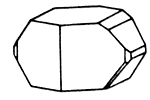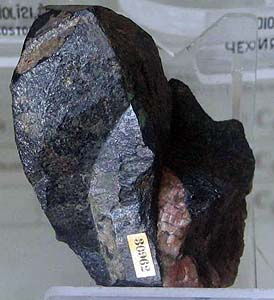Stone, minerals and semiprecious of the world stone
Silicate: Gadolinite -->rus
 Diagnostic cart.
Diagnostic cart.
Y2 Fe Be2 O2 (SiO4)2
Crystal structure monoclinic
Hardness on the Mohs scale 6,5-7
Specific unit weight mass 4-4,7
Cleavage shows up easily
Fracture, break padman, scaly
Colors black, brown-black
Colors in powder triturate grey-green
Glance (glitter, glare) glassy, fat

In nature more frequent than all presented as small accumulations of black (in the changed standards of rifle-green). Crystals mainly very rare, have a prismatic type and sometimes arrive at giant sizes. In a fresh kind (without changes) mineral has glassy brilliance to fat. Fracture, break padman or rough. Gadolinium a ductile malleable silvery-white ferromagnetic element of the lanthanide series of metals: occurs principally in monazite and bastnaesite. Symbol: Gd; atomic no.: 64; atomic wt.: 157.25; valency: 3.
The table of contents of basic components, especially FeO, strongly hesitates; maintenance of SiO2 is most permanent. Dense the masses, grains, rarer - prismatic crystals (usually from the stakes of mm there is to a few sm; weight of some imperfect crystals arrives at 80 kg) (Baringer-khil, the USA); case-box-like and skeletal metacrystal was marked. Radio-active (contains thorium, rarer is uranium).
In passing through mineral light of laser of green with different tints (greyish, bluish) to emerald-green; now and then colourless, sometimes brown. For transparent green Gadolinite is characteristic uneven distributing of colouring (central part of crystals is more dark). In thin microsections pleochroism is not noticeable. In the thick plates of green Gadolinite on Ng and Nm grassy-green, on Np - olive-green; at brown pleochroism is weak: on Ng - brown-yellow, gold, on Np - yellowish-brown. It not Alexandrite !!! In Gadolinite there are cracks of cleavage one-way is not present at the unradio-active black pomegranates of schorlomite.
Diagnostic indication.
Presence of rare-earth elements of thorium and uranium of condition noticeable radio-activity of Gadolinite. Under the action of muriatic acid gel, in flame of candle not melt fuse. Not collect a mineral. Jels with acids (especially easily metamict, of or denoting the amorphous state of a substance that has lost its crystalline structure as a result of the radioactivity of uranium or thorium within it). After burning dissolves in HCl hardly. Crystalline Gadolinite not melt fuse, upwarps and becomes white. Metamiktnyy not melt fuse also, but upwarps so much, cracking, short-transparent, sage-green becomes. At heating there is a flash which brighter at metamict Gadolinite. At heating in the closed tube of crystal Gadolinite strongly made burning hot, not cracking; partly isotropic, poorly made burning hot and cracking after the long heating. At heating in a retort selects the far of water and gases. In the polished microsections all of the usually applied reagents do not operate (characteristic feature).
Origin provenance genesis.
Second mineral; be found in granit and syenitic pegmatites and crystalline slates. In most deposits of selection of Gadolinite covered outside of by the brown crust of afterproducts (it not Monacite).
Deposit minefield mine and use.
In Italy Gadolinite is set in a quartz porphyry in Guasso-al-Monte (province Varese) and in geode of granites of Baveno in Mortofano on main Lago-Major. Gadolinite is in Norway, where found out his accumulation weight about 500 kg, in Sweden, Germany and USA. Obtained in industrial scales as ores on thorium, uranium and rare earths.


Gadolinite. Norway. Gadolinite-(Y). Vyuncpakhk, Keyvy, Kolskiy peninsula, Russia. A photo: © A.A. Evseev.
